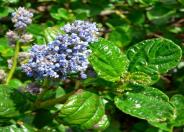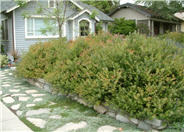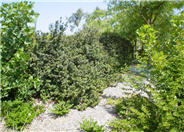
Common name:Carmel Creeper
Botanical name:Ceanothus griseus horizontalis
Carmel Creeper is one of the most popular forms of spreading shrubs. Its glossy oval leaves of 2" are bright green. The tiny, light blue flowers are abundant and form 1" clusters. This shrub benefits from pruning. It does best in well-drained soil with little to no summer water.

Common name:Manzanita Emerald Carpet
Botanical name:Arctostaphylos 'Emerald Carpet'
The 'Emerald Carpet' is an evergreen groundcover that grows to 1' tall by 6'-8' wide. It is favored by many landscapers as the manzanita of choice for inland situations. It has dark green leaves and exhibits compact growth. This variety is relatively tolerant of adverse soil conditions.

Common name:Sunset Manzanita
Botanical name:Arctostaphylos 'Sunset'
This manzanita is a mounding shrub 4'-5' high and 4'-6' wide. It has coppery red new growth, then later turning bright green. It has pinkish-white flowers in winter to early spring.

Common name:Ivy Geranium
Botanical name:Pelargonium peltatum
Clouds of single flowers are produced from spring through fall on this plant, which should be planted in areas that receive part sun.

Common name:Purple Fountain Grass
Botanical name:Pennisetum 'Rubrum'
This grass will reach 6' high and has deciduous, purplish red leaves with clusters of purple flowers that appear in summer and fall. Tall grasses are highly combustible.

Common name:Frades or Compact Escallonia
Botanical name:Escallonia X exoniensis 'Frades'
The 'Frades' is an evergreen shrub that grows to 6'-8' tall and wide. It is valued for its glossy foliage and clusters of pink flowers. The heaviest bloom period is during spring and fall, with some flowers all year. The Escallonias grow best in sun to part shade, but will tolerate mostly shade if necessary. These plants usually need little or no summer watering. This is the most tolerant of poor drainage of all Escallonia varieties.
Designer:
Photographer: GardenSoft
Physical weed control, including mulching, or hand removal protects the watershed from harmful chemicals.
Remove irrigation water and fertilizer from areas where you don't want weeds to grow.